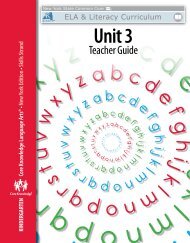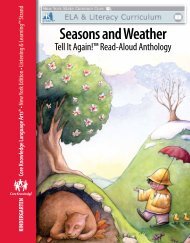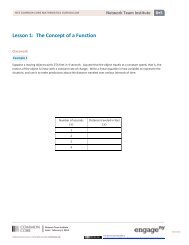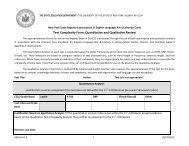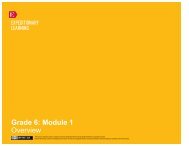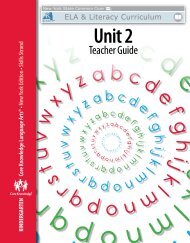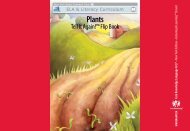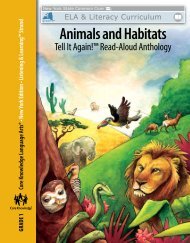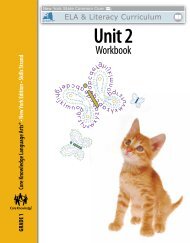Tell It Again! Read-Aloud Anthology - EngageNY
Tell It Again! Read-Aloud Anthology - EngageNY
Tell It Again! Read-Aloud Anthology - EngageNY
You also want an ePaper? Increase the reach of your titles
YUMPU automatically turns print PDFs into web optimized ePapers that Google loves.
7 Fascinated means very interested in<br />
something.<br />
8 the English people who lived in<br />
Plymouth Colony<br />
9 You learned the word tribe when<br />
we studied Native Americans.<br />
What does tribe mean? (a group<br />
of people who share the same<br />
language, customs, and beliefs)<br />
10 [Point to the Native American man<br />
in the center of the picture.] How<br />
do you think he will become their<br />
greatest friend?<br />
11 Let’s say that together: “tiss-SKWAHNtum.”<br />
were doing and stared, fascinated by what they saw. 7 The men<br />
did not look at all like them, and at first the Pilgrims were alarmed<br />
by their appearance. The settlers stood quietly as the men came<br />
closer and closer. They must be Native Americans, they thought to<br />
themselves. Were they friends or enemies? They weren’t too sure.<br />
Then . . . one of the strangers smiled! Suddenly the sense of<br />
danger was gone. One of the men introduced himself as Samoset<br />
and told the colonists 8 that he was a member of the Wampanoag<br />
(WAHMP-ann-oh-ag) tribe of Native Americans. 9<br />
A few days later, Samoset reappeared with the man who would<br />
turn out to be the Pilgrims’ greatest friend. 10 “I am Tisquantum (tiss-<br />
SKWANN-tum),” he told them. 11 “I am of the Wampanoag people, and<br />
I have come to help you.” He held out his hand in friendship to them<br />
and, one by one, the colonists stepped forward to shake his hand.<br />
Tisquantum, or Squanto as he was called, was able to talk to the<br />
Pilgrims because he spoke English. When he was younger, he was<br />
forced by Spanish explorers to go to Spain with them. He was able<br />
to get free and travel to England, where he learned to speak English.<br />
He was then able to get back to his home country.<br />
The Pilgrims did not yet know it at this point, but life was about<br />
to get much, much easier. Their lives would get easier, in part,<br />
because Squanto was not the only Wampanoag who helped them.<br />
Show image 8A-5: Chief Massasoit<br />
12 You also learned the word<br />
chief when we studied Native<br />
Americans. What is a chief? (the<br />
leader of the tribe)<br />
13 [Point to the Native American man<br />
in the picture.]<br />
14 Survival means being able to live.<br />
Why do you think the Pilgrims’<br />
survival was dependent upon the<br />
Wampanoag tribe? In other words,<br />
why did the Pilgrims need the<br />
help of the Wampanoag Native<br />
Americans?<br />
The Wampanoag sachem (SAY-chum), or chief, became a great<br />
and important friend to the colonists. 12 The chief’s name was<br />
Massasoit (mass-uh-SOH-it). 13 Massasoit gave the colonists his<br />
word that the Wampanoag tribe would gladly share their land as<br />
long as the colonists took care of it. “We will teach you how to live<br />
in harmony with nature,” he told them. Being on friendly terms with<br />
the Wampanoag was very important to the Pilgrims’ survival. 14<br />
Columbus and the Pilgrims 8A | The Wampanoag 99<br />
© 2013 Core Knowledge Foundation



